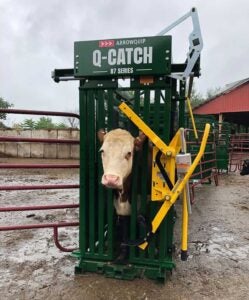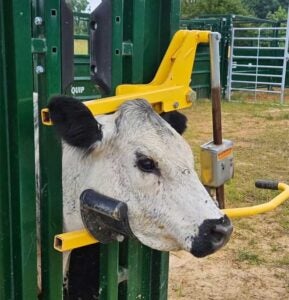No matter the kind of cattle operation you run, or how many head you have on your ranch, having the proper cattle equipment is essential to ensure a safe working environment. With so many choices on the market, it can be difficult to know which option is best — especially for those new to the cattle industry.
One crucial piece of equipment is the cattle head gate. This device plays an important role in assisting with various procedures to keep the handler and cattle safe. Some common instances when a head gate is useful include administering vaccines, branding, tagging, or even milking cattle.
When it comes to cattle head gates, there are two main options that have become a hot topic within the ranching industry: manual and self-catch. With so many conflicting opinions on the two kinds of head gates, it can often lead to myths and misconceptions, which, in turn, can influence buying decisions — even if it isn’t the right decision for your operation.
Choosing the right cattle head gate for your ranch shouldn’t be intimidating, which is why we’ve debunked some common myths to help you make the right decision.
Myth: Cattle head gates are harmful and increase the risk of injury.
Fact: A common misconception (especially from those not in the industry), is that head gates are harmful to cattle and are likely to cause injuries. It’s important to take a step back and look at the evolution of head gates to realize that these devices have come a long way to make sure they don’t harm cattle.
With a self-catch, cattle must run through and hit their shoulders against the head gate to activate the neck enclosures. The force of the self-catch mechanism paired with repeated use can increase stress levels and lead to bruising if the catch isn’t adjusted properly. Manual cattle head gates, on the other hand, allow the operator to be in control the entire time so cattle do not have to run into any hard surfaces. This greatly reduces the risk of bruising, which can lead to higher profits at sale time.

Myth: Cattle head gates are difficult to use.
Fact: This myth stems from outdated views or lack of familiarity with modern head gate designs. Though some companies have continued to make the same cattle equipment for decades, other companies have made advancements to ensure cattle equipment is easier and safer to use.
This especially counts when it comes to the manual catch-style cattle head gates. Though it may take some practice to get used to, this style is often the easiest to use. Often, manual head gates only require one lever to operate and don’t need to be constantly adjusted to suit different sized cattle, which can be handy for any cow-calf operation.
Myth: Cattle can easily escape from head gates.
Fact: Though this may be true for some brands and styles, it is not true for all. One style that offers superior hold is a manual cattle head gate built with a ratchet locking mechanism. This style of locking mechanism allows for incremental adjustments, providing a strong and reliable hold so your animals can’t escape.
Recently, Arrowquip released a new ratchet-style locking head gate that is unlike anything on the market. With up to 7 times the strength of their previous model and less effort required to gain that strength, you can be certain your cattle will be held securely so you can perform any task without worrying about your animals slipping out and compromising safety.
Myth: Cattle are reluctant to enter head gates.
Fact: It may be true that cattle can hesitate or resist entering a head gate. One reason for this may be due to their environment. Cattle can experience something called chute shyness, which can happen because of past negative experiences in a cattle chute. This is most common in cattle who are run through self-catch cattle chutes where animals are forced to hit the equipment to be caught in the head gate.
To avoid chute shyness in cattle, you may want to consider a manual catch cattle chute. This style allows the operator to have full control, meaning they can manually close the head gate on the animal making for a lower-stress environment for everyone.

Myth: Head gates are expensive and not worth the investment.
Fact: The cost of a cattle head gate will vary depending on factors such as size, features, and manufacturer, however one thing rings true: you get what you pay for. While a head gate with a lower price tag may seem more tempting, they are often made with cheap materials which will lead to increased expenses to fix the equipment, safety risks, and a lower lifespan.
When you consider purchasing a head gate, it’s important to think about the company you’re purchasing from and the service that comes with it. What kind of material is the equipment made with and what is the quality? How long is the warranty and what does it cover? How safe will this equipment be for your operation? Though a head gate may be more expensive upfront, it’s crucial to think beyond the price tag.
At the end of the day, you want equipment that is going to keep you, your family, and your livestock safe. When it comes to safety and efficiency, Arrowquip stands out as the leader, creating innovative cattle handling equipment that is designed with ranchers in mind. To learn more about their extensive lineup of equipment, visit their website at arrowquip.com, email leads@arrowquip.com, or give them a call at 1-866-383-7827.
This article was published on behalf of Arrowquip.


